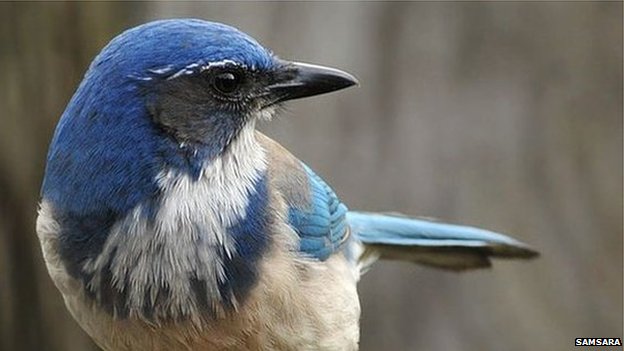The BBC reports that birds hold funerals for their dead.
When western scrub jays encounter a dead bird, they call out to one another and stop foraging. The jays then often fly down to the dead body and gather around it, scientists have discovered . . .
The revelation comes from a study by Teresa Iglesias and colleagues at the University of California, Davis, US. They conducted experiments, placing a series of objects into residential back yards and observing how western scrub jays in the area reacted. The objects included different coloured pieces of wood, dead jays, as well as mounted, stuffed jays and great horned owls, simulating the presence of live jays and predators . . .
The jays reacted indifferently to the wooden objects. But when they spied a dead bird, they started making alarm calls, warning others long distances away. The jays then gathered around the dead body, forming large cacophonous aggregations. The calls they made, known as “zeeps”, “scolds” and “zeep-scolds”, encouraged new jays to attend to the dead.
The jays also stopped foraging for food, a change in behaviour that lasted for over a day . . . The fact that the jays didn’t react to the wooden objects shows that it is not the novelty of a dead bird appearing that triggers the reaction.
This may be news to the BBC, and to Teresa Iglesias and her colleagues, but it would have come as no surprise to Dobson, who considered himself an expert on such matters. The twentieth century’s titanic pamphleteer planned to devote a series of pamphlets to the funerary customs of different types of birds, although only one was ever published. This was Funerary Customs Of Different Types Of Birds, No. 1 : The Seagull (out of print). Here is an extract:
I happened to be present on the occasion when Lord Northcliffe, the founder of the Daily Mail, wantonly beat a seagull to death with his stick. My first impulse was to rush along the promenade towards him and remonstrate, and to snatch the gull-bloodied stick from his grasp and give him a taste of his own medicine. But I was stopped in my tracks by what I saw next. As the press baron stalked off, no doubt dreaming of fascism, there gathered about the corpse of the seagull several boffins in white coats, who deposited around it an array of stuffed or wooden seagulls and owls. They then withdrew, as swiftly as they had appeared, and hid behind a seaside ice cream kiosk. From this vantage point, they watched carefully, taking out notebooks and pencils and scanners and scopes and meters and gauges and similar scientific impedimenta.
Within seconds, dozens of seagulls came swooping down and hovered over their dead pal. The air was loud with the cacophany of their cries. They remained thus for some time, until a municipal seaside dustbin person came along with a shovel and a sack, scooped the bird with the one into the other, and took it away to the nearest bird cemetery. I made to follow him, but in order to do so I had to cross the road, and I did so in Baden-Powell fashion, looking neither to right nor left, not out of blank foolishness but because it is the British way. I thus got it in the back from a passing motor car, and spent the next several weeks in a seaside clinic. I never did visit the grave of the seagull.
As so often with Dobson, it is not quite clear whether this is a true account of events or the babbling of a nutcase. He may well have made the whole thing up for his own private amusement, or to chuckle over with his inamorata Marigold Chew. Equally likely, he may have actually believed it to be true, not realising it was merely a dream. At certain periods in his life Dobson had immense difficulty distinguishing between dreams and reality, never more so than when birdlife was concerned. In a hiatus of – comparative – lucidity, the pamphleteer wrote:
I can never quite convince myself that birds are real, that they actually exist. Whether it be a western scrub jay or a seagull or a stalin or a linnet, or any of the teeming multitude of birds, they seem to me ethereal creatures from the world of dreams. Now, unlike many people, I have never experienced dreams of flight. Rather, my dreaming self summons forth wagtails and nuthatches and swifts and pratincoles, and others of the teeming multitude of birds, sometimes one at a time, sometimes massed in breathtaking flocks. I see the flapping of their wings and I hear their songs. Or do I? Are they not, rather, hallucinatory phantasmagoria, flying images etched upon my brain representing what I would be were I not bound to this too too solid earth by my great clumping feet shod in a pair of Austrian postal inspector’s boots?
That passage is taken from Dobson’s pamphlet Some Unfocussed Thoughts On Birds And Boots (out of print). Unfortunately for the ornithologically crazed, that is all he has to say about birds on this occasion, the following forty-seven closely-printed pages being taken up with a virtually unreadable disquisition upon the Austrian postal inspector’s boots, which may themselves have been “hallucinatory phantasmagoria”, if we are to believe the evidence so diligently collected by Ted Cack in his forthcoming monograph on Dobson’s footwear.
As both the BBC and Teresa Iglesias and her colleagues know very well, birds do exist, in at least three distinct forms, (1) real, (2) stuffed, and (3) wooden. It would be interesting to know what Dobson would have made of that.

